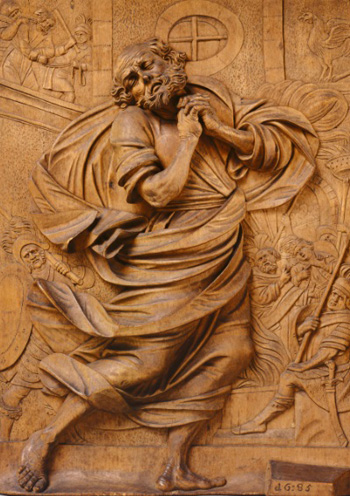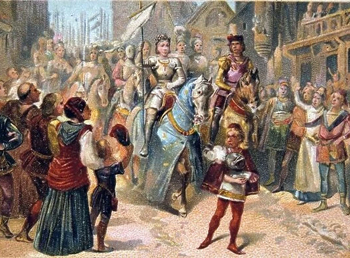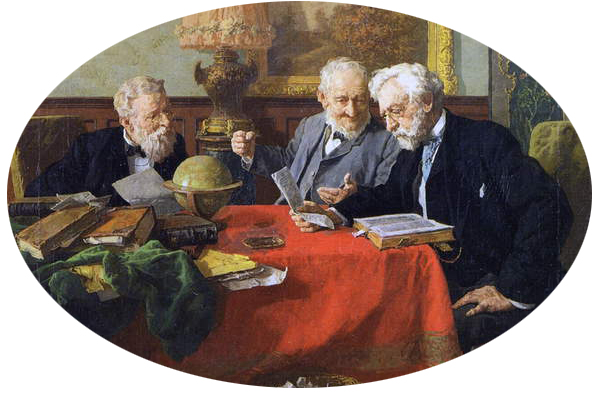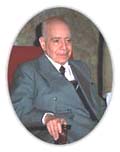Organic Society
 |
 |
 |
 |
 |
 |
 |
Organic Consensus vs Revolutionary Consensus
How do ideas propagate in an organic society? How does this differ from the artificial way they spread en masse today by means of social communication? How does the organic texture of society favor the organic propagation of ideas?
The spirit of a man who truly has faith, hope and charity and practices the four cardinal virtues is made in such a way that he has easy access to the clear, luminous and simple fundamental truths, which are within the reach of all.
He has a certain quality of spirit that allows him to perceive that the truths which he sees are all more or less implicit, one inside the other. When he clearly grasps one primary truth, if he looks further, he also sees a whole gallery of truths, a succession of truths that follow one after another.
He is not a merely theoretical man; rather, he is a very attentive observer of reality. He has an innocent and limpid knowledge of things in the religious order that are born from good sense. Thus he is also philosophical.
 He has the philosophy of those who are not academic philosophers. He has an intuitive philosophy that is well established in his innocent soul. Everything is so crystal clear to him that when someone speaks on these truths, he naturally agrees because those truths on that topic were already more or less established in his mind. This is a type of teaching that has been completely lost by the modern man.
He has the philosophy of those who are not academic philosophers. He has an intuitive philosophy that is well established in his innocent soul. Everything is so crystal clear to him that when someone speaks on these truths, he naturally agrees because those truths on that topic were already more or less established in his mind. This is a type of teaching that has been completely lost by the modern man.
This form of teaching can be compared to a type of fireworks that shoots up into the sky and displays a golden sphere of light from which another and then another sphere burst forth. So then, it is this type of teaching that we are talking about. It is always based on observation and reflection. It is never pure theory. But is also not a stupid observation of reality that does not lead to anything theoretical. It is the harmonic stroll of both observation and theory that produces a consensus which comes from innocence, because all innocent souls are consensual.
Then, how does this consensus develop? It is like the flight of a bird in the air, soaring without obstacles; or like a fish swimming in the water, moving without hindrances. Because of original sin, some difficulties can develop, but after they are explained, things move forward smoothly again. In a fully Catholic ensemble, this is the way things work.
 In a Catholic milieu like this we can speak at length on various topics, even if we are together for a short time, and we leave agreeing upon an enormous quantity of subjects. This is because innocence inhabits some part of those souls who come together, which makes them see one thing inside the other, inside the other etc. For this reason, even persons who do not know one another well can speak freely without fear of not being understood; an assortment of subjects can unfold with all realizing that they are in agreement.
In a Catholic milieu like this we can speak at length on various topics, even if we are together for a short time, and we leave agreeing upon an enormous quantity of subjects. This is because innocence inhabits some part of those souls who come together, which makes them see one thing inside the other, inside the other etc. For this reason, even persons who do not know one another well can speak freely without fear of not being understood; an assortment of subjects can unfold with all realizing that they are in agreement.
This understanding is caused by a grace of Our Lady that restores to a certain degree this limpid innocence in souls.
This is a true consensus because it is the tranquil, luminous and loving possession of the same truths by the same upright men.
This consensus in the counter-revolutionaries has a matrix. This matrix leads them to discern within it to their final last consequences. The truths of the faith enter this operation illuminated by the grace and give them all their sweetest aromas and a great splendor.
Revolution: a bad matrix
 Does the bad consensus also have a matrix? The Revolution is the bad matrix from which everything else comes. So long as this bad matrix exists, the Counter-Revolution cannot be victorious since the revolutionaries spread their filth and vulgarity that is accepted by masses of men.
Does the bad consensus also have a matrix? The Revolution is the bad matrix from which everything else comes. So long as this bad matrix exists, the Counter-Revolution cannot be victorious since the revolutionaries spread their filth and vulgarity that is accepted by masses of men.
What the Counter-Revolution can do is follow its policy of gathering together the good to make its own consensus, which I just described, until a grace comes to shake up everything and give us the victory.
Inside the good consensus there is a tendency toward perfection that causes the best persons to emerge from it in order to lead it.
Here we must focus on two hypotheses: One is the action of one who plays the role of the good leader in a society that resists this goodness. Another is a society that in analogous conditions accepts the good leader and goes forward. The first is similar to the actions of a spiritual director and a penitent who, invited to repent of his sins, revolts; the second is the penitent who repents and moves forward.
In the first hypothesis, the society says no to grace; in the other it says yes. In the latter case, the saint does not necessarily have to sail against the tide in society. Although he may have to push society to move toward where it does not want to go, there is no real enmity between them, and the body of society follows him.
 There are other saints who have to fight against a society that is bad. This is the case of the prophets of the Old Testament who were rejected and stoned.
There are other saints who have to fight against a society that is bad. This is the case of the prophets of the Old Testament who were rejected and stoned.
There are still others who, in the face of a divided society, move the good forward and, for this reason, are hated by the evil; notwithstanding they are able to bring enormous numbers of people with them.
For example, in the 19th century St. Anthony Mary Claret was Patriarch of the Indies – an honorific title, confessor of the Spanish Queen Isabella II, and a magnificent preacher to the people. He was an Archbishop and the founder of the Congregation of the Missionary Sons of the Immaculate Heart of Mary (the Claretians). He was a Catalan and preached throughout Catalonia and other parts of Spain. The missions he preached were so successful that the persons from the village where he had been preaching would accompany him – singing, praying and conversing – along the road to the next village. There he would be met by the people there who were awaiting his arrival. Thus would he go from village to village.
He had a strong influence on a considerable part of society. What is more, he converted the Queen, who was involved in adulterous affairs. We see, then, that St. Anthony Maria Claret did both things: He converted the bad and encouraged the good.
He damaged the course of the Revolution in Spain. Hence, there were attempts to assassinate him, authorities who sent the police after him etc.
 He enthused many and irritated many. So, he swam in the consensus of the little people, but was hated by the Freemasons.
He enthused many and irritated many. So, he swam in the consensus of the little people, but was hated by the Freemasons.
In general the prophet is sent to a society in crisis. He is recognized, but is opposed.
We have another example with St. Joan d’Arc, whom Fr. Cornelius a Lapide considered to be a prophetess. She brought with her all of France. The English did not like her. So, they made arrangements with the Burgundians – who were not entirely French – to imprison her and burn her. But in the French society she enjoyed a general consensus – sadly, a soft one – that allowed her to wrest the King and the French nobility from that softness and wage war. She did not raise the reaction among the people that prophets habitually do, which is to be rejected by them.
Catholic & revolutionary consensus
Thus, the Catholic consensus is formed by two elements: on one hand, the solid stability and innocence of the doctrinal elements and, on the other hand, the upright practice of the cardinal virtues, that is, a great prudence to choose the means to attain the correct end and a great fortitude, which encourages a consensus. These virtues require the good use of the gift of intelligence we received.
On the revolutionary side the consensus is formed around a truth known as such but that is denied by men of ill faith; that truth still exists, but in a state of protest inside the man. He wants to suffocate that truth inside himself by stifling it in everyone around him. He has the illusion that, in doing this, he can achieve an internal peace.
From this position comes the hatred he has toward others who do not think like he does. To reestablish a consensus that he lost inside himself, he wants to forcefully oblige the consensus to adopt a doctrine that is the opposite of the truth that protests inside himself.
In this sense, the first denied truth in our days is the principle of transcendence, according to which beings are not only different from one another but also form a hierarchy. Transcendence is possible only in a hierarchical society, the opposite of our egalitarian world.

Posted December 20, 2023


The spirit of a man who truly has faith, hope and charity and practices the four cardinal virtues is made in such a way that he has easy access to the clear, luminous and simple fundamental truths, which are within the reach of all.
He has a certain quality of spirit that allows him to perceive that the truths which he sees are all more or less implicit, one inside the other. When he clearly grasps one primary truth, if he looks further, he also sees a whole gallery of truths, a succession of truths that follow one after another.
He is not a merely theoretical man; rather, he is a very attentive observer of reality. He has an innocent and limpid knowledge of things in the religious order that are born from good sense. Thus he is also philosophical.

A teaching that unfolds like fireworks with multiple exploding circles of light
This form of teaching can be compared to a type of fireworks that shoots up into the sky and displays a golden sphere of light from which another and then another sphere burst forth. So then, it is this type of teaching that we are talking about. It is always based on observation and reflection. It is never pure theory. But is also not a stupid observation of reality that does not lead to anything theoretical. It is the harmonic stroll of both observation and theory that produces a consensus which comes from innocence, because all innocent souls are consensual.
Then, how does this consensus develop? It is like the flight of a bird in the air, soaring without obstacles; or like a fish swimming in the water, moving without hindrances. Because of original sin, some difficulties can develop, but after they are explained, things move forward smoothly again. In a fully Catholic ensemble, this is the way things work.

The consensus develops naturally like a bird soaring without obstacles
This understanding is caused by a grace of Our Lady that restores to a certain degree this limpid innocence in souls.
This is a true consensus because it is the tranquil, luminous and loving possession of the same truths by the same upright men.
This consensus in the counter-revolutionaries has a matrix. This matrix leads them to discern within it to their final last consequences. The truths of the faith enter this operation illuminated by the grace and give them all their sweetest aromas and a great splendor.
Revolution: a bad matrix

Two types of actions to bring forth consensus are similar to the actions over a bad or good penitent - above, the penitence of St. Peter
What the Counter-Revolution can do is follow its policy of gathering together the good to make its own consensus, which I just described, until a grace comes to shake up everything and give us the victory.
Inside the good consensus there is a tendency toward perfection that causes the best persons to emerge from it in order to lead it.
Here we must focus on two hypotheses: One is the action of one who plays the role of the good leader in a society that resists this goodness. Another is a society that in analogous conditions accepts the good leader and goes forward. The first is similar to the actions of a spiritual director and a penitent who, invited to repent of his sins, revolts; the second is the penitent who repents and moves forward.
In the first hypothesis, the society says no to grace; in the other it says yes. In the latter case, the saint does not necessarily have to sail against the tide in society. Although he may have to push society to move toward where it does not want to go, there is no real enmity between them, and the body of society follows him.

St. Anthony Maria Claret formed a good consesus & damaged the Revolution
There are still others who, in the face of a divided society, move the good forward and, for this reason, are hated by the evil; notwithstanding they are able to bring enormous numbers of people with them.
For example, in the 19th century St. Anthony Mary Claret was Patriarch of the Indies – an honorific title, confessor of the Spanish Queen Isabella II, and a magnificent preacher to the people. He was an Archbishop and the founder of the Congregation of the Missionary Sons of the Immaculate Heart of Mary (the Claretians). He was a Catalan and preached throughout Catalonia and other parts of Spain. The missions he preached were so successful that the persons from the village where he had been preaching would accompany him – singing, praying and conversing – along the road to the next village. There he would be met by the people there who were awaiting his arrival. Thus would he go from village to village.
He had a strong influence on a considerable part of society. What is more, he converted the Queen, who was involved in adulterous affairs. We see, then, that St. Anthony Maria Claret did both things: He converted the bad and encouraged the good.
He damaged the course of the Revolution in Spain. Hence, there were attempts to assassinate him, authorities who sent the police after him etc.

The people gave their hearts to St. Joan of Arc
In general the prophet is sent to a society in crisis. He is recognized, but is opposed.
We have another example with St. Joan d’Arc, whom Fr. Cornelius a Lapide considered to be a prophetess. She brought with her all of France. The English did not like her. So, they made arrangements with the Burgundians – who were not entirely French – to imprison her and burn her. But in the French society she enjoyed a general consensus – sadly, a soft one – that allowed her to wrest the King and the French nobility from that softness and wage war. She did not raise the reaction among the people that prophets habitually do, which is to be rejected by them.
Catholic & revolutionary consensus
Thus, the Catholic consensus is formed by two elements: on one hand, the solid stability and innocence of the doctrinal elements and, on the other hand, the upright practice of the cardinal virtues, that is, a great prudence to choose the means to attain the correct end and a great fortitude, which encourages a consensus. These virtues require the good use of the gift of intelligence we received.
On the revolutionary side the consensus is formed around a truth known as such but that is denied by men of ill faith; that truth still exists, but in a state of protest inside the man. He wants to suffocate that truth inside himself by stifling it in everyone around him. He has the illusion that, in doing this, he can achieve an internal peace.
From this position comes the hatred he has toward others who do not think like he does. To reestablish a consensus that he lost inside himself, he wants to forcefully oblige the consensus to adopt a doctrine that is the opposite of the truth that protests inside himself.
In this sense, the first denied truth in our days is the principle of transcendence, according to which beings are not only different from one another but also form a hierarchy. Transcendence is possible only in a hierarchical society, the opposite of our egalitarian world.

A natural consensus formed by like-thinking men
Posted December 20, 2023

Organic Society was a theme dear to the late Prof. Plinio Corrêa de Oliveira. He addressed this topic on countless occasions during his life - at times in lectures for the formation of his disciples, at times in meetings with friends who gathered to study the social aspects and history of Christendom, at times just in passing.
Prof. Plinio
Atila S. Guimarães selected excerpts of these lectures and conversations from the transcripts of tapes and his own personal notes. He translated and adapted them into articles for the TIA website. In these texts fidelity to the original ideas and words is kept as much as possible.
______________________
______________________






